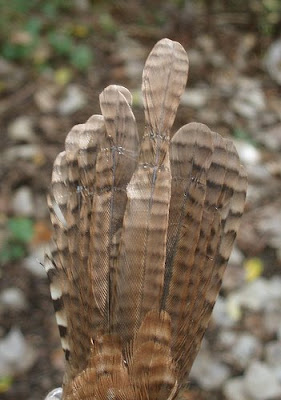The tail feathers of birds, known as "rectrices" or "rects", help with flight, balance, and often sexual display or as a means of signaling and communication. The songbirds we band at RRBO have pretty standard tails -- usually 6 pairs of generally graduated feathers. Every so often, we find an exception.
The tail below belongs to a young (hatching-year, or HY) White-throated Sparrow banded on 5 October 2008. The central rect on the right side was around 10 mm longer than the other feathers. All the rects were fully grown in, so it wasn't a case of the other feathers having not reached their full length.

Also this fall, we got this HY Carolina Wren with a funny paddle-like extension on the central rect. We first caught it on 25 August. The extension was apparent, but the bird was still undergoing its fall molt. However, it was recaptured several times, including in early October, when this funky paddle was still there.

Notice also the odd lines in some of the feathers that look like breaks, or as if the feather was folded. These types of "growth bars" or "fault bars" can occur if feather growth is interrupted, often by a shortage of food due to drought, extended periods of rain, or other environmental conditions. Usually this slow-down of growth creates a fault bar that appears more like a faded line. The Hermit Thrush below has one of these kinds of fault bars, a rather extreme example. In the thrush, the fault bar is an even line across all the feathers. The only time a bird normally grows all its tail feathers simultaneously is as a nestling, so the presence of a fault bar like this can often be used to help age a young bird (although this same pattern can occur in adults that accidentally lose all their tail feathers).
 The Carolina Wren above was not our only paddle-tailed bird. In October 2004, we banded the HY House Wren shown in the next two photos. There are several interesting things about the tail of this bird. Five of its rects had the same kind of paddle-like tip (it was worn off in one of them); these extended about 5 mm past the "normal" ends of the feathers.
The Carolina Wren above was not our only paddle-tailed bird. In October 2004, we banded the HY House Wren shown in the next two photos. There are several interesting things about the tail of this bird. Five of its rects had the same kind of paddle-like tip (it was worn off in one of them); these extended about 5 mm past the "normal" ends of the feathers. All the tail feathers were fully grown in except for the three on the right in the photo below. Any feather that gets pulled out will begin to regrow immediately. Several weeks prior to capture, this wren had lost these three feathers which were now nearly replaced. Note how much fresher and blunt-tipped they are compared to the three feathers on the outer left.
All the tail feathers were fully grown in except for the three on the right in the photo below. Any feather that gets pulled out will begin to regrow immediately. Several weeks prior to capture, this wren had lost these three feathers which were now nearly replaced. Note how much fresher and blunt-tipped they are compared to the three feathers on the outer left. In many species of birds, HY individuals have more pointed outer rects than do adult birds. This is an especially useful tool to help age warblers -- I'll do a post in the future with some better examples of how we use feather shape to help age birds. Finally, note that the wren appears to have one extra tail feather. The tip of the second feather on the left looks split in two, but you can see the feather has only one shaft.
In many species of birds, HY individuals have more pointed outer rects than do adult birds. This is an especially useful tool to help age warblers -- I'll do a post in the future with some better examples of how we use feather shape to help age birds. Finally, note that the wren appears to have one extra tail feather. The tip of the second feather on the left looks split in two, but you can see the feather has only one shaft.Wrens and sparrows haven't cornered the market on extra tail flourishes. We occasionally capture Cedar Waxwings that not only have those pretty little red waxy tips on their wing feathers (specifically the secondaries, or inner wing feathers), but also on the tips of their rects. I've also heard these waxy tips may occur in rare instances on the outer wing feathers (primaries) or the row of feathers over the wing feathers (greater coverts). The function or purpose of these waxy tips -- wherever they occur -- is not known.
 We always keep our eyes peeled for these interesting little oddities.
We always keep our eyes peeled for these interesting little oddities.









